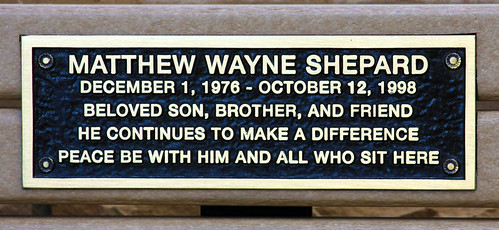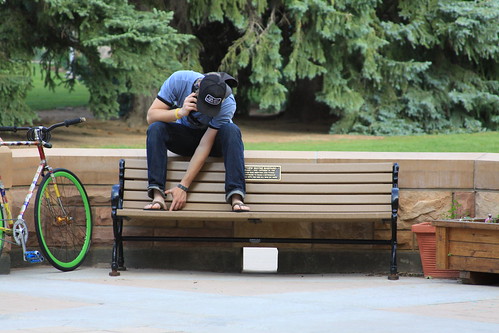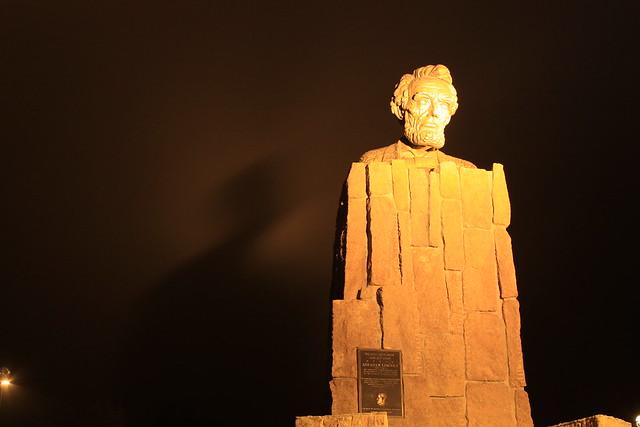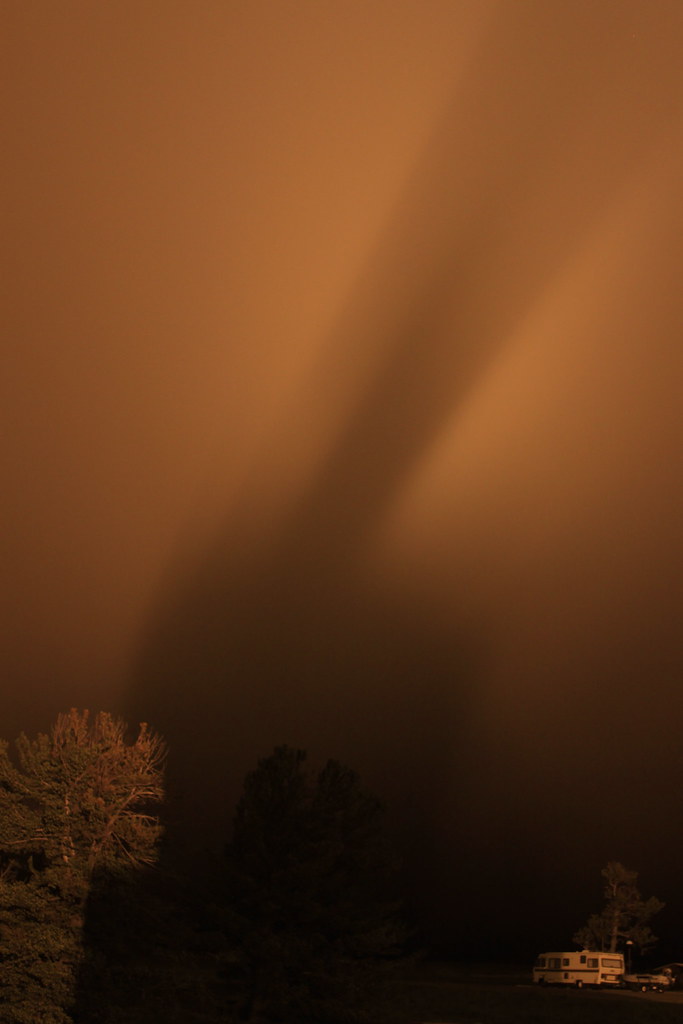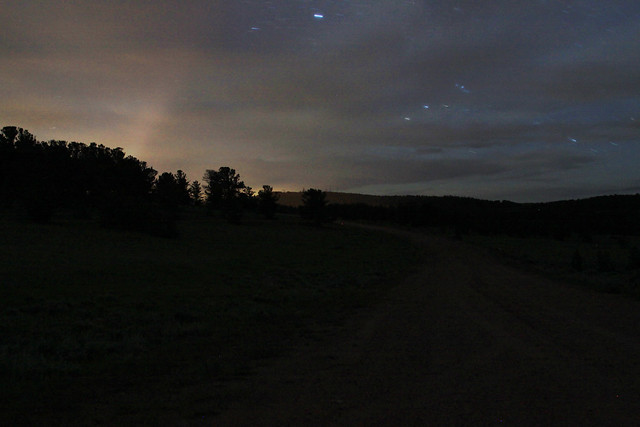
In The Laramie Project: 10 Years Later, we learned about the Shepard memorial bench on the University of Wyoming campus, which is parked at the front of the Arts and Sciences building. (That's A&S there at the right.) In addition to holding the university's main concert hall venue, A&S is also home to the Political Science department (Matt's university home) and a lot of administration.
A&S holds a privileged location on campus, too: of all the enormous buildings which ring Prexy's Pasture, the functional center of the university, A&S occupies the entire western end, and the pasture in front of it sometimes feels like a grassy mall leading up to its front steps. (The bench is basically right behind that maroon van.)
So, without any further ado, here's the bench, with a closeup of the plaque:
It really is a sweet gesture, I think. It gives Matt an important place on campus to permanently commemorate his life, and it's both right in front of the A&S college and in a high traffic area when the A&S auditorium is being used. I especially like the positive message of the plaque. It commemorates Matt, not as a victim, but one who made a positive impact. After so much bad press after his murder, I think reminding the campus that Matt was a person, and one who has made a positive difference on everyone there is important. And, doing it on a piece of furniture means that people will actually interact with the memorial is a great way to set the right tone. This isn't a cumbersome monolith that forces an ambivalent memory upon a campus still covering its scars. Rather, it invites remembrance to those who stop to enjoy its presence.
So, yes, I rather like the placement and wording of the Shepard memorial, but if someone took a brisk walk around camps and even around town, she would realize that Shepard's commemoration is hardly unique. For instance:
Here we have an identical bench dedicated to former UW president Phil Dubois and donated by the Trustees. It's located a little farther up Prexy's pasture, on the side nearest to A&S.
This one is dedicated to former president Dubois' mother (complete with crow droppings from the flock of crows roosting on A&S):
This one was paid for by the Dubois family, as she passed away in 1999. The former Mrs. Dubois has her bench only about seventy-five feet from the plaza in front of A&S, sort of between A&S and Merica Hall just to the south.
There are lots of these benches around campus, and I'm willing to bet at least a dozen of them have memorial plaques, to everyone from beloved former professors to admins. (I think one I saw was for a donor, but I have no idea, really.) So, at this point I bet you're thinking, "Wow, the Shepard memorial bench isn't unique at all!" I'm afraid so-- in fact, these benches are not just a campus phenomenon. Here's one dedicated to Cal Rerucha, the former DA who prosecuted both McKinney and Henderson in 1999-2000:
You can tell from the picture that these are not the same kind of benches; I think they're part of a city rather than a university project. These benches, which sit on the north (Ivinson Avenue) side of the county courthouse, are not really reserved as memorial markers, judging by the presence of a bench with a plaque for Wal-Mart stores (I think it's the one just past the upper left-hand corner of this photo. Rather, they're more like tiny billboards. I think that's the point of the Reruchas' plaque on this one: it simply names himself and his wife as "attorneys at law." What better place for a lawyer to hang out his shingle than in front of the courthouse, eh?
So, I guess there are two different ways to look at Matt's bench in the context of the surrounding environment. The negative one might complain that Matt's memorial isn't really all that special, and the only way they managed to get on campus was to sneak it in under a campus beautification project. It's almost like saying, "Okay, we'll actually let you mark the campus with his memory, but his memorial can't draw attention to itself..." Honestly, I suppose that's how I felt about it when I first wandered about the campus that afternoon, but I think that there's a second, positive way to think about the bench.
What helped me change my mind? On the way back to my car one afternoon, I was walking back towards Prexy's in the direction of my car when I saw this fellow chatting on the phone:
Seeing this student casually tracing his hands down the bench as he talked on his phone made me stop to think: what are the chances that this kid will look down and see the plaque? Maybe he will, but he might not, either. Even though this student's act of remembrance isn't what most people think when they try to picture commemoration, this interaction with Shepard's memory on his own terms shows how the bench incorporates Matthew's memory into the very fabric of UW's landscape. This is unlike a normal memorial marker, like the one for the Challenger explosion on the west side of campus. When I lived on campus, the Challenger astronauts' stone and bronze marker only really got any attention when someone used it as a hole for Frisbee golf. Then some of us felt a little queasy about the idea of slapping the Challenger astronauts in the face with a golf disc, and eventually we moved the hole. After that, none of us really even noticed it anymore.
In contrast to the Challenger memorial, Matt's bench gets a lot of daily interaction because it's designed for interactive experience. As students look for a quiet spot to read and bask in the sun, they seek it out. And, since it's part of a larger network of memorial benches to other beloved people, the bench presents who he really was to the campus: someone who was a part of the UW community and whose life has indelibly left its mark on us all.
One evening after photographing Old Main, I stopped to have a seat on the memorial bench myself. As I sat in the lengthening shadows of A&S, I could gaze upward to its highest floors dressed in sandstone, or the huge, stately pines which dominate the green spaces on the north side. To my left was Prexy's Pasture, with its diamond pattern of walkways leading to the family/unity statue in the center, and the flagpoles for the university, state, and nation beyond. It's a good place to sit and ponder, I decided, and as students do that, they meet with a little piece of Shepard's life. And every time we do, we remember a little piece of Matt.


